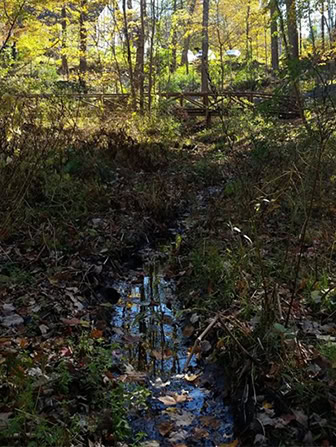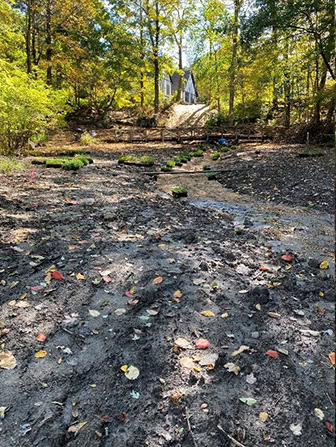Wildflower Woods Wetland Restoration
Wildflower Woods is home to many native plants and is located just off Teatown’s the main parking lot.
This woodland demonstration area was fenced in 2010 to show the effects of white-tailed deer browsing on local forests. Its location allows for increased public visibility, but also brings increased impacts from its proximity to the road. The slope of the parking lot collects stormwater and sediment from the road and channels it toward Teatown Lake. As a result, the Wildflower Woods wetland and Teatown Lake have been filling in with excess sediment for many years.

Figure 1: WFW wetland before project start.

Figure 2: WFW wetland during construction.
The goals of this project were to reduce the amount of sediment entering Teatown Lake from the main parking lot, restore the sedimented area back into a wetland, and create a space for educational opportunities. To accomplish this, a sediment catch basin was installed to collect runoff from the parking lot and filter out dirt and debris. The sediment caught in the basin will be regularly emptied so only water finds its way into the wetland. The wetland area was also regraded by removing excess sediment and creating a new channel for water to flow to the lake. A massive replanting effort (over 7,000 plants!) was completed in the fall of 2020. These plants will add biodiversity and native food sources, while helping filter out excess nutrients (like nitrates and phosphates) from the water as the plants establish in the wetland.
This project was funded through a grant awarded by the Land Trust Alliance (LTA) and the generous contribution of an anonymous donor.
FAQ
When was this project completed?
July 2021. The final step was to install a boardwalk the connects the bird blind to the trail near the entrance to Wildflower Island. This boardwalk gives visitors an inside look to a restored wetland and is complete with signage that talks about the project.
What species were planted in the wetland?
Over 40 native wetland species were selected for this project, including Swamp milkweed, Tussock sedge, Button bush, New York aster, Winterberry, Golden alexander, and Swamp azalea just to name a few.
Why is there string?
The fencing and string around the new plantings are to discourage geese from landing in the project area while we wait for the plants to establish. It will be removed before spring 2022.
What wildlife will benefit from this project?
This restoration will have a far-reaching impact, providing habitat and food sources for many species of birds, amphibians, turtles, and small mammals.

